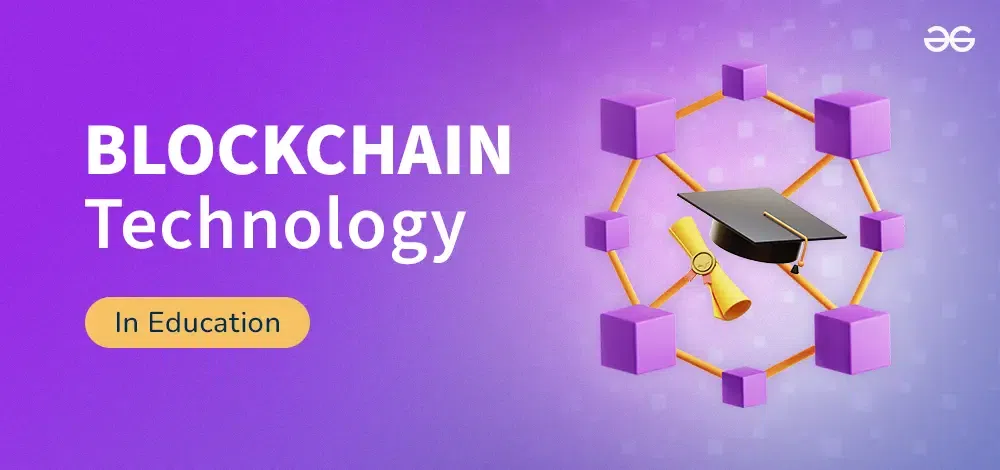Blockchain technology in education, like other emerging technologies such as artificial intelligence and virtual reality, has brought new waves of change and introduced solutions founded in diverse industries that go beyond its initial financial and cryptocurrency focus. The opposing global factors to crypto growth and the volatile valuations of bitcoin have made the crypto frenzy bleak.
The underlying technology supporting cryptocurrencies, blockchain, remains adamant and stable. This is because the primary aim of the blockchain was not wealth creation or digital assets rather it was to solve problems across different sectors that hindered progress. The increasing adoption of blockchain technology demonstrates its strengths. Blockchain has several applications, but one area where it is proven to be a game changer is education.
What is Blockchain?
Blockchain is decentralized, meaning no single entity has control over the entire chain; instead, control is distributed among nodes, and a distributed ledger records transactions across a network of computers. Here, a ledger means that it is a record-keeping mechanism where transactions or data can be recorded. The transaction details are not stored in a single node but distributed across nodes in the chain, implying that every node or participant in the network has a copy of the entire chain, and the changes are constantly updated across the nodes.
We can understand blockchain with a simple analogy. Blockchain is a digital record-keeping system; consider it a giant spreadsheet where every transaction is documented and secured. The spreadsheet is continuously growing, and every new block contains encrypted information about itself and past transactions. Every node in the blockchain has a copy of the entire chain; hence, it cannot be tampered with. Transparency and security make it ideal for recording valuable information like financial transactions, property ownership, votes, etc.
Why the Education Sector Needs Blockchain
Education is one of the most crucial sectors for mankind. Global spending on education is expected to reach $7.5 trillion by 2025. The education sector continues to wrestle with legacy systems like record-keeping by students and employees; academic records and credentials of students are all done manually. This old way of keeping records can easily lead to impersonation. Educational institutions use a manual identity management process. The manual identity management process leads to difficulties in keeping track of qualifications and certifications. Moreover, they also use time-consuming, paperwork-intensive methods to keep track of the student’s progress. These procedures take more time and reduce efficiency in the education sector.
Role of Blockchain in Education in 2024
Blockchains have the power to generate unique digital assets that authenticate the integrity of academic credentials and certificates. Aside from credential verification, blockchain has various applications in education and employment. Let’s look at the practical use cases:
1. Student Records
Universities throughout the world have realized that blockchain is the ideal instrument for storing, tracking, and utilizing students’ credentials. It allows students and learners to quickly and easily access their data and securely share it with potential employers. Learners have complete control over their records because they are not saved on university servers but on blockchain technology. The adoption of blockchain in managing students’ records holds immense potential as it can create a learner-centric education system. The security of the records would be enhanced, the administrative process would be smoothed, and accessibility to the records would increase drastically.
2. E- Transcripts
Blockchain also brings the amazing potential of e-transcripts along with verification. Producing a transcript for an academic institution can be a time-consuming and labor-intensive task around the world. To ensure the correctness of the transcript, the authorities have to manually cross-check each entry in the transcript. This case-by-case inspection is very time-consuming and can lead to mountains of paperwork. Even in the year 2024, schools will send or receive transcripts using old techniques like mail.
The above process can be made efficient by technologies such as distributed ledgers or related solutions, which can easily help in catching fraudulent claims of unearned academic credits. It can work wonders for schools by enabling tamper-resistant storage of sensitive data like grades, etc. Other than the academic folks, the recruiters also benefit, as it makes the verification process simpler for firms, resulting in huge time and monetary savings.
3. Publishing & Copyright Protection
Plagiarism is a severe problem in the academic world, a lifetime worth of labor can be lost when a research paper is stolen or copied. One who has done authentic work can get low grades due to his content getting copied. Blockchain-based solutions can be used to regulate how copyrighted content is distributed online. The primary goal of the system will be to safely keep the captured data in a chain. This data is secured by state-of-the-art encryption, so once it is saved, it cannot be manually altered. Students can now safely access instructional resources thanks to this. Because the chain tracks how the content is used, the owner may easily control access. It is feasible to track online usage, and it is easy to establish possession.
4. Automated Learning Platforms
The teachers can enter into a digital agreement with the students regarding completing their tasks, projects, etc. using blockchain smart contracts. In the agreements, all the requirements, instructions, due dates, or deadlines are outlined. Smart contracts help with course management, which leads to a personalized learning pathway. The decentralized governance and secured data empower students to take a self-sufficient approach to education. The automated learning platforms through blockchain lead to an increase in efficiency, flexibility, and an inclusive educational experience for learners worldwide.
5. Payment via Cryptocurrencies
Cryptocurrencies that are based on blockchain technologies make transactions easier. International students can pay their university fees on the other side of the world in seconds or minutes. Paying via cryptocurrencies makes the process hassle-free, as they don’t have to convert their currency or face intermediaries. Moreover, the conversion rates are not applied, which makes the process student-friendly. Educational institutions can make use of DeFi (Decentralized Finance) solutions for lending, borrowing, and managing financial assets, providing students with new options for funding their education. Various universities across the world have started accepting cryptocurrency, such as Simon Fraser University in British Columbia, the University of Nicosia, and King’s College in New York.
Challenges of Blockchain Technology
The use of blockchain by educational institutions hasn’t accelerated despite its obvious benefits. Their apprehension comes from the obstacles such as:
- Scalability concerns: Educational institutes generate a huge amount of data with the rise in the number of students and certifications. Blockchain systems find it challenging to scale up as the amount of data stored increases. The simple logic is that as the amount of data grows, the transactions become slower. Moreover, peer-to-peer verification makes the transactions longer. Presently, new methods are being invented to scale blockchain systems.
- Legacy Solutions: Various education institutions still rely on old methods that involve a lot of paperwork for document management. Awareness needs to be spread about moving systems to the blockchain, highlighting its many benefits to driving a change in the education system concerning technology.
- Cost: For the authorities in educational institutes, the high upfront cost of setting up a blockchain system overshadows its numerous benefits. Some institutions may find it difficult to spend a significant amount of money, but others may find it difficult since implementing blockchain technology will necessitate a significant overhaul of the current infrastructure. Hence, work needs to be done to bring the setting-up cost within the range of the university’s finances and the initial investment and incentives from the government have to be given.
- Security issues: Although blockchain promises to be one of the most secure technologies, However, it is not immune to damage, and the volatility of the cryptocurrency may not fit into edtech business standards. Additional security measures, such as permissions and stronger data encryption, should be developed to improve security.
Want to become a blockchain developer check out How to Become a Blockchain Developer?
Conclusion
It is necessary to remove the apprehensions and hesitations regarding blockchain technology. Blockchain technology has the potential to bring drastic changes to the education sector, which will have a great long-term impact on education. Technological developments in education will fundamentally alter how students enroll in and consume courses. Blockchain disruption in edtech will automate course advancement and learning paths for learners using smart contracts built on blocks, giving them ultimate control. Blockchain will prove to be incredibly useful in the educational industry. It enables educational institutions to protect the data of their students. They can claim ownership of their qualifications, awards, diplomas, and academic identity. It fosters trust and transparency among educators, managers, and learners.
Must Check
FAQs
What are blockchain’s primary applications in education?
There are many use cases for blockchain in education. Some of them are storing student records, e-transcripts,automated learning platforms, publishing and copyright protection, etc.
What is the future of blockchain in education?
Blockchain will drastically change how students enroll in and use courses in the educational system. Blockchain promises to make education transparent, safe, and available to everyone.
What are the hurdles related to implementing blockchain in education?
Scalability challenges due to the increasing volume of data, unwillingness to switch from legacy solutions,high upfront setting up cost, and security risks are all obstacles. Efforts are underway to solve these difficulties and promote the use of blockchain in education.





